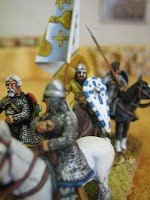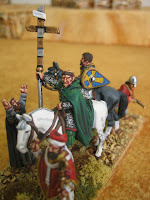
THE MOLLWITZ CAMPAIGN
Following Frederick’s invasion and occupation of much of Silesia during the winter of 1740 – 41 the Austrian high command charged General Neipperg with its recovery. At the end of March 1741 he led 15,000 Austrian reinforcements into Upper Silesia. The Prussians were still dispersed in winter quarters and this move caught them by surprise.
Neipperg advanced slowly through the mountain snow and did not reach Nysa until 5 April. His force, now numbering 19,000, was enthusiastically welcomed by the citizenry who proclaimed the Austrians as liberators. Both troops and commander were supremely confident of victory, (Austrian hussars had taken to bleating “bah, bah” at the Prussians they encountered), so instead of taking time to rest, the force advanced to the town of Mollwitz where they found the protestant population far less helpful and welcoming.

Meanwhile the Prussians had not remained inactive. Frederick had ordered any troops blocking the advance of the Austrians not to risk an engagement. Instead they were to fall back whilst the two main bodies of Prussian troops under the command of himself and Schwerin found time to concentrate. When on 10 April this united force of 21,600 marched unexpectedly from the south of Mollwitz, thus placing itself between the Austrians and their Moravian base, it was the Austrians who were surprised.
Any advantage the Prussians had achieved was now lost as they took an absurdly long time to carefully, and as it happened imprecisely, to deploy. This gave the Austrians time to hurriedly form an infantry line under the cover of a cavalry screen.
The first of many battles between the forces of Maria Theresa and Frederick was about to begin…………

SET UP AND RULES
This scenario was written specifically for use with Piquet (as are most of my scenarios). Coverting it for other rule sets will be fairly easy providing that special rules for "Frederick leaves the field" and "Occupying Mollwitz" can be devised.
INITIAL DISPOSITIONS AND SCALES
The deployment map shows the battle as set up for my own 25mm figures on a 10’ x 6’ table where a typical 4 stand 16 man infantry unit has a frontage of 16cm.
Each unit represents approximately 2 cavalry regiments or 4 infantry battalions. Consequently the troop ratios are slightly out, especially with regards to the cavalry formations of either side (See Deployment Map Key for actual composition).
Romer’s cavalry has been deployed in the position it took after being bombarded by Prussian artillery and just prior to its first attack. This is key to game balance. Romer’s
rear line cavalry are in column of route.

NOTES ON TERRAIN
The snowfields (readers will notice that snow in my world is green) of Mollwitz are flat. The streams are bounded by boggy ground but I have assumed this would have been frozen solid and, consequently, easy to traverse.
DEPLOYMENT MAP

MAP KEY AND ORBATS (One for the Austrians, One for the Prussians).


SEQUENCE DECKS
Sequence decks are as per the standard Piquet Cartouche supplement except that the Prussians side has a Charismatic Leader card added. (See below).

FREDERICK LEAVES THE FIELD.
Following Romer’s successful attack Frederick was advised to leave the field lest he be captured. He did so, on a horse later called “The Mollwitz Grey”. To simulate this when the Charismatic Leader card is turned the Prussian player must roll a d12 Vs his total number of destroyed or routed units and leaders. If the check is failed Frederick leaves the field. If he leaves the field or is killed 2 dress the lines cards must be added to the Prussian deck and 5 morale chips are lost. The 2nd in command is Schwerin who must supersede command in the usual way.

OCCUPYING MOLLWITZ
Although the Austrian commanders are confident, their infantry is not. If, at any time, they choose to occupy the buildings of Mollwitz, the army will deem the move to be a retreat in the face of the enemy and their morale might be shattered. If Austrian infantry occupy Mollwitz before the Prussians roll D6 and D8: The result is the number of morale chips lost by the Austrians.
VICTORY CONDITIONS
This is a very hard battle for the Austrians to win especially as their infantry is so poor (they were described as raw recruits and militia). To win the Austrians, must stay on the field for 7 turns (until nightfall), voluntary withdrawal off table is not allowed, and they must inflict at least 66% as many casualties, in units destroyed and routed, as they suffer. Anything less is a Prussian victory.
FIGURES AND OTHER BITS
All figures are Front Rank or Wargames Foundry. All were Painted in enamels by Olicana Painting Services (that would be me). Terrain tiles by TSS. Trees and walls mainly by Last Valley. Streams scratch made from the perspex sides of an old shower unit. Roads scratch made from fibre glas sheet, polyfiller and scatter. Building scratch made from card and polyfiller.

































